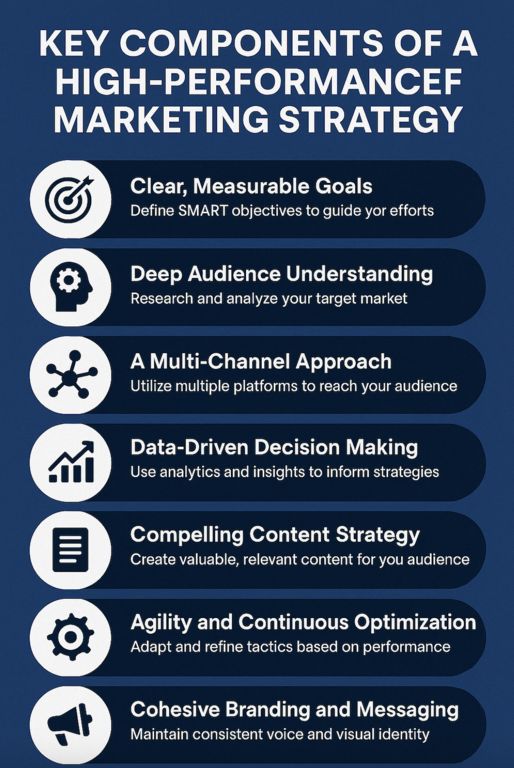In today’s ultra-competitive digital landscape, businesses of all sizes are asking the same question: How do we stand out?The answer often lies in having a high-performance marketing strategy — a well-structured, data-informed, and goal-driven approach that doesn’t just make noise, but delivers real results.
So, what makes a marketing strategy high-performance? It’s not just about spending more or being everywhere at once. At Traffic Company, we believe it’s about precision, adaptability, and integration.
1. Clear, Measurable Goals

A strategy without goals is like a ship without a destination. Defining clear, measurable objectives is the first and most important step in any marketing plan. Are you aiming to increase brand awareness, drive sales, generate leads, or expand into a new market?
High-performance strategies break down these broad goals into SMART goals:
- Specific
- Measurable
- Achievable
- Relevant
- Time-bound
For example: “Increase website traffic by 25% over the next 3 months via SEO and PPC campaigns.”
These kinds of defined targets help align your team, track progress, and identify what’s working (and what’s not).
2. Deep Audience Understanding

You can’t create high-performing campaigns without knowing who you’re talking to. Effective marketers dig deep into their audience’s needs, behaviors, pain points, and preferences. This process includes:
- Building buyer personas
- Conducting market research
- Analyzing customer feedback and behavior
Understanding your audience helps tailor messaging, choose the right platforms, and design experiences that resonate on a personal level. It also helps you avoid wasting time and budget on channels or content your audience doesn’t care about.
3. A Multi-Channel Approach
Today’s consumers are everywhere — on social media, search engines, mobile apps, and more. A high-performance strategy doesn’t rely on a single channel but leverages an integrated, multi-channel approach that keeps the brand consistent while tailoring content to fit each platform.
Some core channels include:
- Search Engine Optimization (SEO)
- Pay-Per-Click Advertising (PPC)
- Email Marketing
- Content Marketing (blogs, whitepapers, videos)
- Social Media (organic + paid)
- Affiliate and Influencer Marketing
By weaving these channels together, your message reaches users at multiple touchpoints in the buyer journey, increasing your chances of conversion.
4. Data-Driven Decision Making
High-performance marketing is as much about analytics as it is about creativity. Every decision — from copy tweaks to budget shifts — should be informed by real-time data and user behavior.
Tools like Google Analytics, Hotjar, Meta Business Suite, and marketing automation platforms provide insights such as:
- Conversion rates
- Bounce rates
- Traffic sources
- Audience demographics
- Engagement metrics
More advanced strategies use A/B testing, customer journey mapping, and predictive analytics to refine performance continuously. The idea is to move from gut-feeling marketing to evidence-based execution.
5. Compelling Content Strategy
Content is more than just blog posts — it’s the voice and value your brand provides to its audience. A high-performance content strategy is built around:
- Solving audience problems
- Educating and informing
- Entertaining or inspiring
- Guiding customers through their decision-making process
It’s also essential to format content appropriately — short videos for social platforms, in-depth articles for SEO, and interactive tools for lead generation.
Every piece of content should serve a purpose within the broader funnel, whether it’s awareness, consideration, or conversion.
6. Agility and Continuous Optimization
Markets change, algorithms shift, and consumer behavior evolves — often quickly. That’s why agility is a cornerstone of high-performance marketing.
Your team needs to:
- Test ideas regularly
- Monitor key performance indicators (KPIs)
- Be ready to pivot based on what’s working
- Cut out underperforming elements
- Scale successful tactics quickly
The best strategies are living, breathing frameworks — not rigid documents collecting dust.
7. Cohesive Branding and Messaging
Even the most technical strategy fails if the branding feels scattered. A strong, consistent brand voice across all channels fosters trust and recognition.
This includes:
- Visual identity (logos, colors, design)
- Tone of voice (professional, playful, bold, etc.)
- Messaging pillars (your core brand themes and values)
Cohesion ensures every campaign supports your brand’s overall story, enhancing long-term customer loyalty.
Conclusion
A high-performance marketing strategy is not built overnight. It requires clarity, curiosity, discipline, and a deep commitment to knowing your audience and optimizing your approach over time.
By combining goals, insights, channels, content, and analytics, brands can create campaigns that not only attract attention — but inspire action and loyalty.
In the fast-moving world of digital marketing, performance isn’t just about visibility. It’s about intentional, scalable, and meaningful growth.
What is a high-performance marketing strategy?
A high-performance marketing strategy is a carefully designed plan that uses data, insights, and multiple marketing channels to achieve specific, measurable business goals. It’s built for scalability, optimization, and long-term success.
How do I set measurable marketing goals?
Use the SMART framework — goals should be Specific, Measurable, Achievable, Relevant, and Time-bound. For example, “Increase email sign-ups by 20% within 90 days” is a strong, trackable goal.
Why is audience research important?
Understanding your audience helps you create relevant content, choose the right platforms, and deliver personalized experiences. The better you know your customers’ needs and behaviors, the more effective your campaigns will be.
What does a multi-channel marketing strategy look like?
It involves reaching your audience through multiple platforms — like social media, email, SEO, PPC, and content marketing — with a consistent message. This ensures you connect with people at different touchpoints in their buying journey.
How can I make my marketing strategy data-driven?
Incorporate analytics tools (like Google Analytics, Meta Ads Manager, or HubSpot) to track campaign performance. Use insights to make informed decisions, optimize campaigns, and experiment through A/B testing or user behavior analysis.
What makes content “high-performing”?
Content that solves a problem, educates, entertains, or inspires your audience tends to perform well. It should be relevant to the target audience, aligned with business goals, and optimized for the platform it appears on.
How often should I review and update my strategy?
Continuously. High-performance strategies are agile — they adapt to changing data, trends, and goals. It’s good practice to review performance monthly and do a full strategy review quarterly.
Can small businesses implement high-performance strategies?
Absolutely. While big budgets help, high-performance strategies are more about precision than spending. With clear goals, smart targeting, and consistent analysis, even small businesses can see significant results.
How important is branding in marketing strategy?
Very. Consistent branding — in tone, visuals, and messaging — builds trust and recognition. It’s a key piece that connects every element of your marketing into a cohesive experience for your audience.
What’s the first step to building a high-performance strategy?
Start with your goals. Know what you want to achieve, then build out your audience profiles, select channels, create relevant content, and set up analytics for tracking. From there, test, learn, and optimize.

